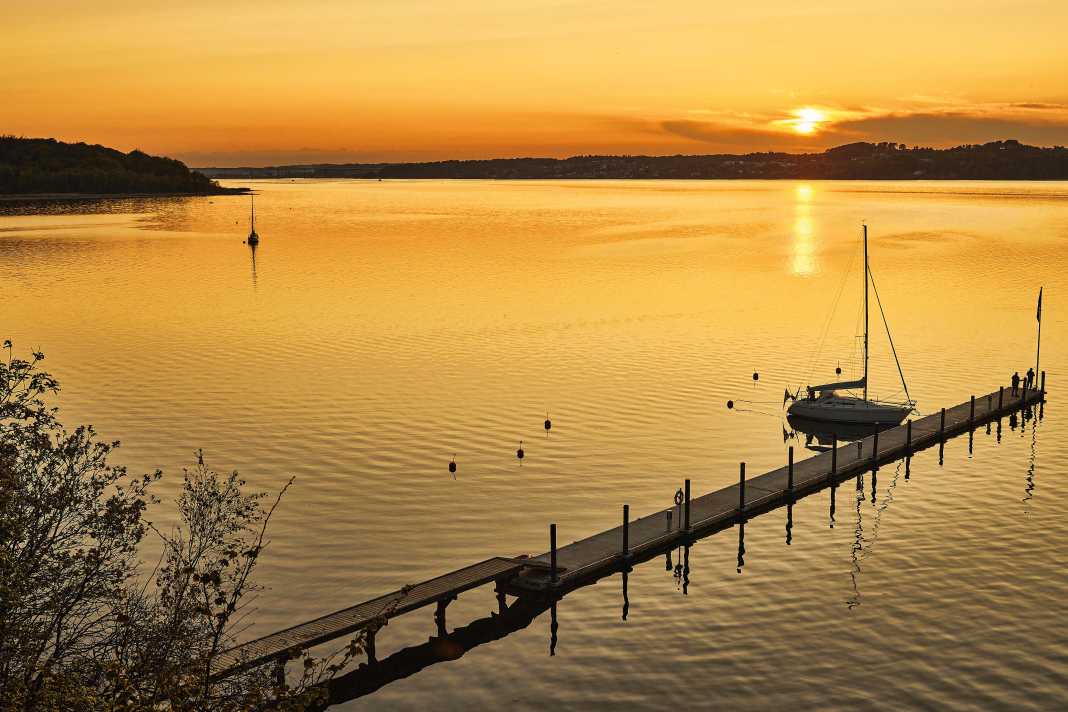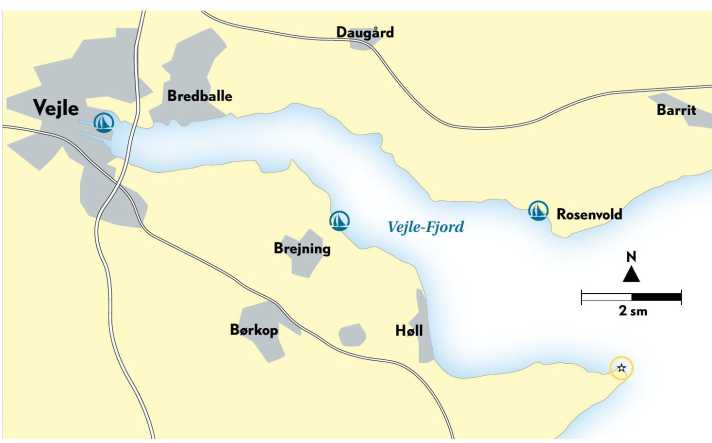Fjords Denmark: The Vejle Fjord - where nature meets spectacular architecture
Nico Krauss
· 11.08.2023






The fjords between Fredericia and Aalborg are not large sailing areas. But they surprise with unexpected diversity. Each one offers pretty harbours, perfect anchor bays and great land attractions - enough for a whole holiday. We introduce you to them:
- Vejle Fjord
- Horsens Fjord
- Mariager Fjord
Many sailors head north from the German coasts on holiday. The jump to Samsø or even to the more distant Anholt is popular. Beautiful destinations, no doubt about it, and ideal for mile-makers. Those who want to take it slower and prefer to sail short legs will find peace and relaxation in the southern islands of Denmark. Unfortunately, it gets very crowded here in many places in the high season.
But there are alternatives. In the west, on the Danish Baltic mainland, the central Jutland fjords of Vejle, Horsens and Mariager stretch from south to north. Each has its own charm, each offers variety on the water as well as on land. Above all, they are all sheltered areas where crews of small cruisers, trailerable boats or dinghies will also find ideal conditions for great trips.
14 nautical miles of shoreline with cliffs, beech forests, fields and beaches

Like the other two fjords, Vejle Fjord takes its name from the town deep inside the inlet. These places have always been important for settlement and trade when shipping was still the number one means of transport: protected from storms and easily accessible for the onward transport of goods over land. Coming from the south from the Little Belt, it is around six nautical miles by sailing boat from Fredericia to Kasser Odde, a headland that extends far into the Kattegat, even under water. It therefore makes sense to sail around the laid-out cardinal buoy to the east.
To the west, the way is then clear into the wide funnel of the Vejle Fjord. Apart from a shoal on the northern shore of the inner fjord called Træskohage, which is equipped with a fire of the same name, the approach poses no problems. At 14 metres, the mouth of the fjord is quite deep. Only in the western part does the bottom rise to four metres. The last mile into the city harbour of Vejle is always deeply dredged, as cargo ships also sail here.
There are 14 nautical miles to log from the opening at Kasser Odde to Vejle. The route takes you past varied shores with steep cliffs, beech forests, fields and beaches. There are many anchorages along the way, offering shelter on the leeward sides of the forests and steep banks. You can usually anchor close to land. There are also three marinas with guest berths. The jewel is located right at the entrance to the fjord: Rosenvold Havn to the north. It adjoins a sandy beach and the hinterland is wonderful for walks and cycle tours.
Vejle Fjord also has a lot to offer on land
But as is the case with jewels, they are in high demand. The few guest berths in the tiny harbour are quickly filled. With winds from the north to north-east, the ground tackle is set in the sand off Rosenvold Pint: the beach and a headland covered in heather, gorse and pine trees give the crew a premium view from the cockpit.
There is more space and comfort on the southern shore in Brejning Havn in the centre of the fjord. Continuing towards Vejle, Andkær Vik, probably the most beautiful anchorage in the area, follows behind a headland on the southern shore. Well protected from winds from the south-west to south-east, it offers space for a dozen yachts.
The Ice Age left a moraine directly on the shore of the bay, the steep wall of which can be climbed. There are sleeping huts and a fireplace at the top. From here, the view across the bay to Vejle is particularly enjoyable at sunset.
Modern architecture can then be marvelled at in the western fjord. Anyone familiar with the old Vejle will be surprised: instead of silos, warehouses and large tanks, the city's waterfront is now characterised by almost futuristic-looking residential and office complexes. There are also restaurants, cafés and museums. While the boat stays in the large marina, the crew can explore this modern maritime urbanity - it's worth it!
Nature in imbalance- Vejle fjord collapses
Only recently, headlines made the rounds that the Vejle Fjord had collapsed. According to the researchers, the fish population has declined massively and there is hardly any seagrass left. The reason for this is the so-called dead zones, in which the water no longer contains any oxygen. This is due to the fact that warmer surface water absorbs less oxygen than colder water as a result of rising temperatures. In addition, a higher temperature weakens the circulation movements, which is why even less oxygen reaches great depths. Such dead zones also exist in the German Baltic Sea, but so far only very far down. However, the Vejle Fjord is only a maximum of 15 metres deep, and only at the transition to the open Baltic Sea - a frightening development according to the researchers. This is because the dead zones pose a massive problem for the ecosystem.
Vejle Fjord: Tips for shore leave
- The Fjord Festival, a large folk festival and spectacle with theatre, a children's programme and music, takes place at the end of August every year. ( fjordfestival.vejle.dk )
- For art connoisseurs: the Fjordenhus by artist Olafur Eliasson. ( fjordenhus.dk )
- For history fans: the rune stones of Jelling. ( natmus.dk )
- Family crews can take a trip to Legoland, which can be reached in an hour by bus. ( legoland.com )
Further information about the area
The Vejle Fjord is easy to sail. However, the water levels can fluctuate considerably depending on the wind. The harbour fee for nine-metre yachts is usually 130 to 180 Danish kroner (equivalent to 18 to 24 euros). Payment is usually made at a machine or online. The town of Vejle at the end of the fjord is ideal for a crew change. It is easily accessible by train via Hamburg-Flensburg-Kolding or via the E45 motorway.
Recommended reading for a trip to the fjords
- Jan Werner: "Cruising Guide Denmark 1, Jutland - Anholt - Læsø" (31,99 Euro)
- Peter Hotvedt: "Harbour guide, Denmark and southwest Sweden" (69,90 Euro)
- Set consisting of the Delius Klasing sports boat chart sets 1, 4 and 5: "Danish Baltic Sea + Bay of Kiel" (199,90 Euro)
Fjord or fjord? The origin makes the difference
In Scandinavia, the term fjord refers to an arm of the sea that extends deep inland. From a geological point of view, however, there are differences in how they were formed, and the process of formation also explains the different characteristics of the landscape. According to geological interpretation, fjords were formed by the process of glacial erosion during the ice ages. The ice masses carved deep furrows in the rock massifs, and as they melted they left behind outflows towards the sea. The Norwegian fjords are exemplary for this. In the case of a fjord, a different geological process was at work: as a result of the coastal formation being altered by the advancing ice masses and the rise in sea level after the last ice age, the sea was able to penetrate the flat areas. Storms and tides put the finishing touches to the landscape. This was the case on the Jutland mainland. The landscape and water depth of the fjords were also characterised by factors such as rock type, vegetation and erosion. This also explains the different characters of the Vejle fjords, Horsens and Mariager explain.

